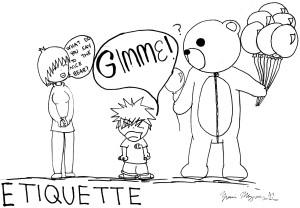
By: Yumi Miyazaki
It is not rare to find a spoiled child in today’s society. The screams of ‘I want’ and ‘give me’ fill the air and temper tantrums are a common sight to see. These children believe the world revolves around them– what they want, they get.
How the child creates such a thought process and builds such a character goes back to the original debate of psychology: nature vs. nurture.
“Some common characteristics of spoiled children are self-centeredness,the belief that everything revolves around them, and the lack of motivation and patience. They’re unable to focus on one thing besides themselves,” said school psychologist Sean Mulcrone.
Nature delves into genetic and other factors of the natural world that one cannot control. Genetic disposition enhances their chances of forming characteristics of a spoiled child.
For example: let’s say a study shows that a person with dominant gene A is more likely to have a strong sense of ego. Strong ego leads to strong pride and self centeredness.
Nurture dictates that environmental factors lead to forming the character and thought process of a spoiled child.
With society feeding the needs of a spoiled child, another item to observe is parenting style. Parents are obviously at the core of a child’s thought processing. Parenting molds a person.
Clearly being a parent is very difficult. A simple action that a parent takes for what he or she believes to be for the sake for the child could potentially affect the child in a drastic matter. But the objective of all parents is this: they want their children to be happy. How they go about doing it is a different matter.
Take a look at these examples: Teen A’s 16th birthday is coming up and he or she wants a car. Parents A and B buy it for him or her. Teen A is out recklessly driving one night and runs it into a tree. Parents A and B fix the car for Teen A. The car needs new tires, brakes, etc. Parents A and B fix everything for Teen A when he or she asks.
Versus: Teen B’s 16th birthday is also coming up and he or she also wants a car. However Parents C and D instead of just buying it for him or her decides upon a condition. Teen B must be passing all of his or her classes with a B or higher by the time of his or her 16th birthday. Teen B studies hard and manages the grades. Teen B receives the car. Teen B also recklessly drives and runs into a tree. Parents C and D pay for the expenses up front but Teen B is made to pay it back by finding a job.
The difference between parenting styles of Parents A,B and C,D is motivation. Teen A is unmotivated to do much, whatever he or she needs or wants Parents A and B provide. Teen A does not have to do anything– he or she just keeps asking for what they need and want. Teen A forms a mindset of ‘what I need I get, everyone works for my needs’.
Teen B on the other hand, although provided what he or she wants, must work for it. Parents C,D mold Teen B in such a way that he or she is motivated to work for his or her wants and needs. Teen B forms a mind set of ‘I must work for what I want and there is value to the work I do’.
Reinforcement
Another example is reinforcement. In psychology, reinforcement does not always mean a good thing. Reinforcement is used as a general term of what one receives after performing an action. There is both positive reinforcement and negative reinforcement. Positive does not stand for good but rather addition and negative does not stand for bad but for subtraction.
Example: Child A is at the store and he cries for Parent A to buy him or her candy. Parent A buys Child A candy.
By buying the candy Parent A is positively reinforcing Child A’s behavior. Child A learns that if he or she throws a tantrum for what he or she wants, he or she will receive it. Parent A buys into Child A’s demands which reinforces the Child A’s self-centered thinking process.
Although these are simple examples, the reality is that how people are raised, some natural factors and the values that they believe in determine whether they are selfish or not. It’s not something one can control. However that does not mean it is something one cannot change. Given the opportunity, change is inevitable.





